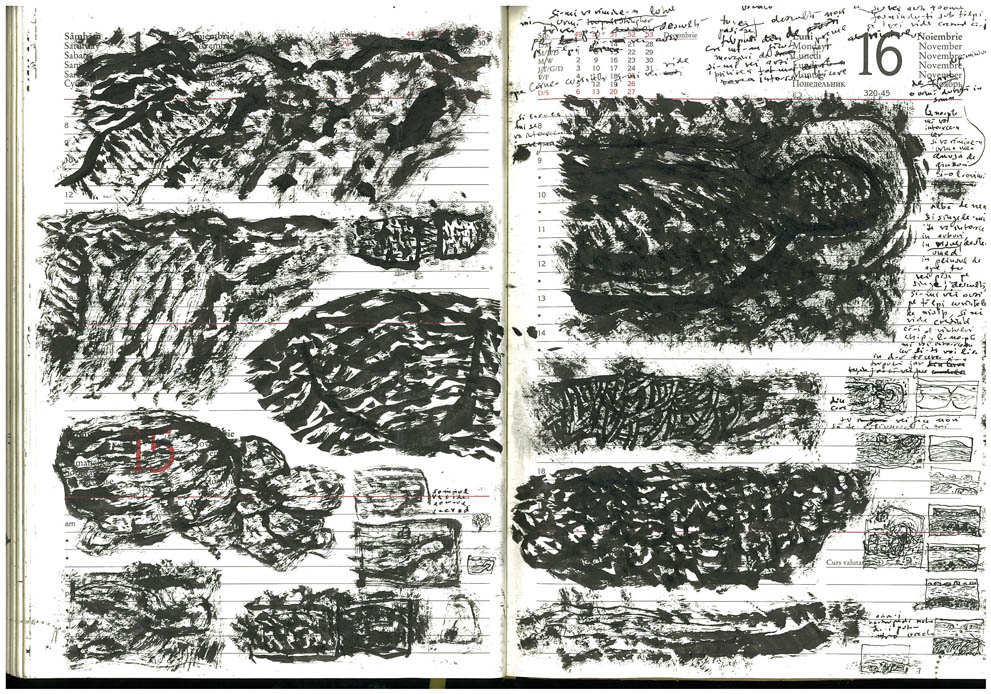Dragoş Dascălu STORIES AND TOOLS
For a long time, architects who have assumed a social mission believed in the power of space to shape an
For a long time, architects who have assumed a social mission believed in the power of space to shape an individual. To stimulate him, to limit its movements, to direct, and finally, to generate a certain behavior. In the purest positivist spirit (characteristic to that age), they believed in the truth of architecture, an objectivity that can transcend the perception of the individual‑user and which, once applied, can shape the individual in a determined and calculated manner.
Tony Garnier, one of the Modernist dreamers, was convinced that «only the truth is beautiful. In architecture, truth is the product of calculations made to satisfy known needs by known means.» (1) However, starting with the ’70s, the post‑structuralist critique of the creation of discourses, the formation of social institutions that promote the discourse and the expression of power by those who generate the discourse led to a new and more ethical understanding of the relationship between architecture and the individual‑user. «The truth» (held by experts), whatever it may be, becomes less important. The individual is regarded as an expert in his / her own right and his / her way of perceiving reality (always subjective) begins to be taken into account.
Through daily narratives the individual builds reality. Through narratives we understand and communicate our perception of reality, and architecture is often a part of them. Either as stage or as actor (2), the street, the threshold, the room, the stairs are all part of our daily narratives. In other words, we understand, experience and pass on our own experience of the built space through our own «stories» and through the multitude of shared personal narrations (we each understand space and architectural objects differently, but not completely independent of a common perception).
That may mean, of course, multiple interpretations and also, in time, even misinterpretations of the meaning of architectural space or the architectural object (3). But, at the same time, it can also be a great asset for the architectural processes and its resultant spaces. Personal stories can be one of the most interesting tools of architecture or urban planning that undertake a social role. «The stories build relationships» (4). Relations trigger processes. Processes can lead to the creation of spaces.
The Dudley Street Initiative, a movement that proposed urban regeneration of a neighborhood in Boston characterized by depopulation, physical degradation, and the sharp decrease in property values, started in the ’80s in a manner similar to many other urban regeneration projects: a plan generated by professionals meant to be implemented with funds offered by a foundation which was unknown to most residents. Due to residents’ opposition to such an approach, the strategy was changed radically. Instead of a predefined plan, the developers went on to meet the people and to listen to their stories. The problems, disappointments, and hopes expressed by these stories were used to generate the first actions in the district. (5)
The personal stories were used to find the best spaces and the best suited actions to start a gradual process of urban regeneration. The success of the first actions has caused more people to open up and feel empowered. To expect more from their neighborhood and to feel that they can get and generate this change on their own. Therefore, the Dudley Street initiative’ s mission has become to empower the neighborhood residents to «organize, plan, create and control a vibrant, diverse and high quality neighborhood, in collaboration with community partners» (6). We’re talking about a process of urban regeneration with an integrated perspective. It’s not only the space that counts. Improving the quality of space is a result of a larger process of residents’ empowerment, the creation of social institutions with a strong power of action, and reduction of social distances. And the stories were the first and the most important tool used permanently. The act of telling stories is archetypal. But this does not explain the power that individual narrations may have and neither any underlying mechanisms.
In the most direct manner, the personal stories link to familiarity, to unproblematic elements of the past, or routine. Using these unproblematic elements can help to easier management of unknown elements, whether we are talking about situations, individuals, places, objects. It is a strategy for reducing the complexity of the external world, and a way to prevent anxiety related to unknown (7). A built intervention that always replaces an existing order, the routine, with a new and unknown one, may cause rejection or anxiety. Therefore, if used correctly, the personal stories can become a tool for generating individuals’ closeness and for stimulating the space or the resulted object nearness.
But mere familiarity does not fully explain the mechanisms behind the personal stories. The exposed personal stories, discovered by someone else (especially since the person is not known), become acts of confidence testing. The person reveals itself and becomes vulnerable, whilst the «other» can profit from this opening. The cost of such gesture is however small. The one telling the story has little to lose from this revelation when trust is betrayed. Thus, the story is a tool that can fundament the building trusting relationships. In addition, as we saw in the case of Dudley Street initiative, once the personal stories get real effect in space, resulting in a neighborhood urban regeneration, the level of individual empowerment relating the story increases as well. There is a whole literature related to the relationship between narrative, narration, narrators and power relations. Who says, who hears, what is the relationship between them. What is the aim in telling the story? Is this a form of legitimacy of the narrator? In case of practices like the ones mentioned above, we are dealing with a transformation of individuals generally excluded from the decision‑making process into agents. The story of the individual generates effects. The individual becomes an agent. Thus, the personal story is not just a confidence building tool, but also a tool of empowerment of the individual Important to add as well, the story is a form of face to face interaction, of direct knowledge between individuals. Their own experiences, shared and debated in a relatively narrow frame and face‑to‑face, may contribute to reduce the social distances determined by differences in knowledge, age, race, etc. It can also reduce the abstract category of «other» stereotypes. Shared experiences are real, they affect the everyday life and individuals can more easily relate to them. It is a lesson known since the early 20th century by visionaries like Jane Addams, who believes that the immediate, common, everyday experience matters more than anything else in social relations (8). Thus, the personal story is a tool for reducing the social distance between individuals.
References:
- Banham, Reyner, (1980) [1960], Theory and Design in the First Machine Age, Cambridge: MIT Press, p. 36.
- Based on Bruno Latour and Actors Network theory.
- Charles Jencks extensively discusses the relationship between the brand, perception and intention in case of large objects of architecture, in his book The Iconic Building. In his view, the successful iconic buildings are those that manage to blend with the real, local stories, to become part of everyday narratives in a positive way, even if they sometimes differ considerably from the original intention of the building. «Paranoia and misunderstanding accompany the iconic building», p. 57.
- Putnam, Robert, Feldstein, L. (2004), Better Together. Restoring the American Community, New York, London, Toronto, Sydney: Simon&Schuster. p. 21.
- Ibidem, pp. 75–86.
- www.dsni.org/
- Anthony Giddens and Niklas Luhmann refer to the «basic trust» or familiarity as a social mechanism to reduce the outer world complexity.
- Sennett, Richard (2012), Together. The Rituals, Pleasures and Politics of Cooperation, London: Allen Lane.
- Public works (2011), Folk Float News from Egremont and Glasgow, [online] at http://www.publicworksgroup.net/log/1175/folk‑float‑news-fromegremont-and-glasgow
But how could architects use this tool to create an architecture closer to the individual‑user? Obviously, we cannot talk of a recipe. Still, there are some outstanding examples: EichbaumOper created by raumlabor or the Folk Float created by publicworks, a team of architects – artists. With the ultimate aim of creating a museum and an archive related to the former mining town residents of Egremont, Scotland, the publicworks team designed a project to ensure the future of the relationship between the space and the people it should represent. In short, the idea is to convert an electric car used for delivering milk (a milk float) into a multifunctional mobile architectural object, to act as a showcase exhibition and to gather items from local residents for the future museum. It is these objects per se that become the tool and the means connecting the individuals. During the 2 months in which the car circulated in Egremont, Folk Float gathered both a local archive, various objects and publications of Crab Fair Archive association, constituted informally, as well as objects from the local residents. «Donations could include anything, from a family portrait to a local music CD, a vegetable grown at home, a winning lottery ticket or the latest joke popular in Egremont. During the first exit, donations have included a picture of a winning dog, a giant zucchini and a boxing trophy. Folk Float informs this new idea of local museum and aims to become a critical tool in this endeavor. The Folk Float direct contact with its audience is meant to build a better understanding of how to manifest a future museum, both physically as well as conceptually.» (9) The objects people from publicworks talk about are not just any objects. Each of them is actually a part of a lived history, with personal stories to tell. The donation and display of these objects becomes a tale told by an individual in public. Thus, the objects – stories become tools for creating a new type of museum. The stories are tools within the architectural creation and each participant becomes creator by the stories displayed.
The daily narrations of each of us can be tools for creating new types of spaces, objects, functions. And each of us can be a creator of space, as part of a collage of narrations. Many architectures that have assumed a social role and use such tools have managed to break the dominating relationship between the expert and the individual – user, of the unique story imposed by the planner, to which the individuals – users are just spectators. Unfortunately, these architectures are still marginal and require a reinvention of the architect’s role. And this reinvention is not yet reconciled with existing architectural system (training, common practice, discourse). Moreover, in terms of town planning, such practices are even rarer. Unfortunately, most often in urban regeneration projects, the urban planning, urban design, and planners are still seeking the perfect scientific, and objective formula to shape society and individuals. Yet cities respect much less the drawn plans than architecture. Fortunately, it is precisely the individual stories that will change, misappropriate, or ignore the experts’ stories and, in the end, always generate pleasant and lively cities.
 Romană
Romană English
English



